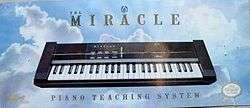Miracle Piano Teaching System
| Miracle Piano Teaching System | |
|---|---|
 | |
| Developer(s) | The Software Toolworks |
| Publisher(s) | The Software Toolworks |
| Designer(s) | Jon Mandel, Henrik Markarian |
| Platform(s) | Nintendo Entertainment System, Super Nintendo Entertainment System, Mac, Commodore Amiga, Sega Genesis, PC. |
| Release date(s) | 1990 |
| Genre(s) | music, non-game |
| Mode(s) | Single player |
The Miracle Piano Teaching System is a MIDI keyboard/teaching tool created in 1990[1] by The Software Toolworks for the NES and SNES, Apple Macintosh, Amiga, Sega Genesis and PC.
Description

The Miracle system consisted of a keyboard, connecting cables, power supply, soft foot pedals, and software either on 3.5" floppies or standard, licensed NES/SNES/Genesis cartridges. After the supplied MIDI keyboard was connected to a console or computer and the included software was loaded, a user followed the on-screen notes. Its marketed value was as a tool to teach kids and to play the piano. It provided hundreds of lessons,[2] and was advertised as the perfect adjunct to formal lessons. Due to its high price (US$500) and low sales, the keyboard with all of the original cables together are a rare find. Factory sealed copies of the Sega Genesis version can be worth up to US$412.[3] Aside from being released in the United States, the Miracle Keyboard was also released in multiple regions within Europe. The European versions are, however, much harder to find. Some of the NES Miracle keyboards were also later converted for PC use - the Nintendo Seal of Quality on these boards was covered up with a piece of plastic.
With the exception of the metronome that was used in the Miracle system's lessons, the Miracle system did not ever generate sounds through the video game console hardware; all MIDI information from the console was converted into audio by the instrument's built-in ROM and played through the instrument's stereo speakers, allowing the keyboard to be used independently of the console.
Features

Students can learn to play classic piano, rock piano or show tunes.[4] The Miracle system would use artificial intelligence to assess the player's ability before creating custom lessons.[5] Fun exercises were meant to make learning the piano seem less like a chore and more like playing a video game. Instead of using the traditional NES controller, the piano became the controller as players aimed at targets in order to perfect their music skills.
There are multiple games that students can play to help teach musical skills. One game is called Robo Man where the player has to press the correct keys at the right time to create a bridge. If they miss, Robo Man falls and the player loses. Another game is a duck hunting game. The player has to press the keys that correspond to the positions of the ducks on a musical staff to shoot them.[6] In the "Ripchord" game, players must press the correct combination of keys for a chord to land paratroopers onto a target.[6]
Reception
Computer Gaming World liked the Miracle system's games and graphics, describing them as "not only entertaining and challenging, but they are also cleverly designed to reinforce the lessons". The magazine concluded, "everything that Software Toolworks promises about this system is true [but] there is still no substitute for parental involvement".[7] David Wesley and Gloria Barczak mentioned that the system was praised by educators and that in 1990 it was the highest-rated third-party NES title by Nintendo's software review team.[1] At the same time, the Miracle system failed commercially with its expensive price and in comparison to later music-related titles such as Guitar Hero. It was not well-suited to average gamers who lacked musical experience or who were not highly committed and dedicated to undertaking long-term electronic piano learning.[1] PC Magazine mentioned the system as being easy to use and likely more patient than a live piano teacher though the system did not cover certain aspects of piano playing such as hand position.[2]
Successors
Around 1995, technology from the Miracle system was incorporated into the Piano Discovery System, an interactive PC software title that worked with a MIDI keyboard and which was published by Jump! Music.[8][9] By 1997, the Miracle product had been discontinued in favor of the Piano Discovery System, the latter of which could be used with the original Miracle Piano MIDI keyboard.[10]
References
- 1 2 3 Barczak, Gloria; Wesley, David (2012). Innovation and Marketing in the Video Game Industry: Avoiding the Performance Trap. Gower Publishing, Ltd. (retrieved via Google Books). p. 197. Retrieved 2014-04-22.
- 1 2 Kendall, Robert (August 1992). Miracle System Turns Your PC Into a Patient Piano Teacher. PC Magazine (retrieved via Google Books). p. 618. Retrieved 2014-04-22.
- ↑ "Sega Genesis Rarity Guide". RarityGuide, Inc. Retrieved 2016-08-02.
- ↑ Free, John (February 1993). Electronics Newsfront. Popular Science (retrieved via Google Books). p. 30. Retrieved 2014-04-23.
- ↑ Stover, Dawn (August 1990). Electronics Newsfront. Popular Science (retrieved via Google Books). p. 32. Retrieved 2014-04-22.
- 1 2 Brown, Lonnie (1992-08-22). "'Miracle' in a major key". Lakeland Ledger (retrieved via Google Books). p. 10C. Retrieved 2014-04-23.
- ↑ Rich, Jason R. (April 1992). "The Software Toolworks Puts a Miracle into Music". Computer Gaming World. No. 93. pp. 58–59. Retrieved 21 May 2016.
- ↑ "Piano Discovery System Uses PC to Make Music Lessons Easy and Fun.". BusinessWire. 1995-05-05. Retrieved 2014-04-26.
- ↑ "Jump! Music to Publish Piano Discovery System; Multimedia music tutorial system will join comprehensive line of music products". BusinessWire. 1995-09-18. Retrieved 2014-04-26.
- ↑ "Questions about Miracle Piano". Jump! Music. Archived from the original on 1997-01-05. Retrieved 2014-04-26.